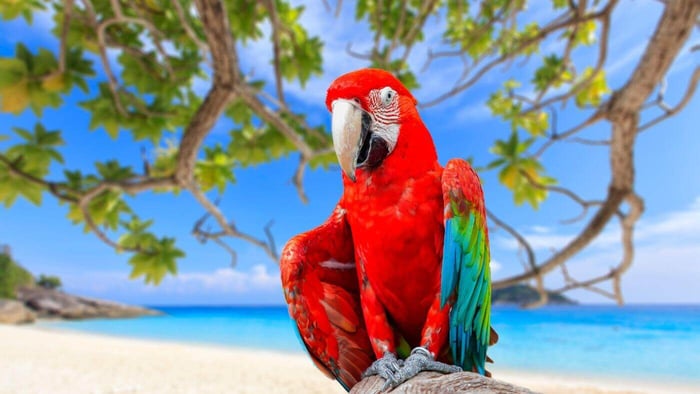Where Do Parrots Come From?
Where Do Parrots Come From? Exploring the Ancient Origins of Parrots – A Gondwanan Legacy
The question "Where do parrots come from?" has intrigued scientists, bird enthusiasts, and naturalists alike for centuries. Parrots, with their vibrant colours, remarkable intelligence, and unique ability to mimic human speech, have always been a source of fascination. Recent studies suggest that the answer to "Where do parrots come from?" lies deep within Earth's geological history, pointing to the ancient supercontinent of Gondwana. This theory not only illuminates the evolutionary journey of parrots but also connects their origins to the broader history of Earth's land masses.
Where Do Parrots Come From? Tracing Parrots Back to an Ancient Supercontinent
To answer the question "Where do parrots come from?" we must journey millions of years back to when Earth was quite different. Gondwana, a massive landmass that existed in the Mesozoic era, included what are now Africa, South America, Australia, Antarctica, the Indian subcontinent, and the Arabian Peninsula. The breakup of Gondwana, which began around 180 million years ago during the Jurassic period, set the stage for the evolution of many species, including parrots.
The separation of these ancient lands not only reshaped the planet's geography but also played a crucial role in the development of life as we know it. In answering "Where do parrots come from?", scientists have pointed to this period of geological change, suggesting that parrots' ancestors were once part of this great supercontinent.
Geographical Clues and Ancient Fossils: Revealing the Origins of Parrots
When considering "Where do parrots come from?" geographical distribution and fossil evidence provide compelling answers. Today, the majority of parrot species are found in the Southern Hemisphere, particularly in regions that were once part of Gondwana, including South America, Australia, and Africa. This pattern of distribution suggests that parrots' evolutionary roots are intertwined with the landmasses that once made up Gondwana.
In addition to geographical clues, fossil discoveries offer further insight into "Where do parrots come from?" The oldest known parrot fossils, dating back about 50 million years, have been found in Europe and North America. This suggests that parrots once had a much broader range, occupying both the Northern and Southern Hemispheres. Over time, however, as Gondwana fragmented, parrots became confined to specific regions, contributing to their present-day distribution.
These ancient fossils also provide a direct link to the evolutionary journey of parrots. They help scientists piece together how these birds may have evolved in response to the changing landscape of the planet.
Genetic Insights into Parrot Evolution: Tracing the Lineage
When asking, "Where do parrots come from?" genetic studies offer another important layer of insight. Advances in genetic sequencing have enabled scientists to trace the evolutionary lineage of parrots with remarkable precision. By studying the DNA of various parrot species, researchers have discovered that parrots share a common ancestor with a group of birds known as Passeriformes (songbirds). This genetic connection further supports the theory that parrots originated from the ancient supercontinent Gondwana.

The breakup of Gondwana led to the isolation of these bird populations, which created an environment for divergent evolution. This genetic isolation allowed parrots to evolve into the diverse species we see today, each adapted to their specific environments. In answering "Where do parrots come from?", these genetic insights confirm that parrots' ancestors evolved in the isolated ecosystems that emerged after Gondwana split apart.
Adaptations Reflecting an Ancient Habitat: Evolution in Gondwana's Forests
One of the most intriguing aspects of parrot evolution is their unique adaptations, which can be traced back to their ancient origins. The theory that parrots originated in Gondwana offers a clear explanation for some of their most distinctive traits. Parrots are known for their strong, curved beaks, which are perfectly suited for cracking tough seeds and nuts. These beaks likely developed in response to the dense forests of Gondwana, where such food sources were abundant.
Additionally, parrots possess zygodactyl feet, which means they have two toes pointing forward and two backward. This adaptation is essential for climbing and grasping, traits that would have been invaluable for parrots navigating the dense, tree-filled environments of ancient Gondwana. These specialised feet allowed parrots to easily perch and move through the forest canopy in search of food and shelter.
The unique features of parrots—strong beaks and zygodactyl feet—are direct products of their evolutionary journey. These traits reflect the challenges and opportunities presented by the ancient habitats of Gondwana and explain how parrots thrived in such environments. When asking, "Where do parrots come from?" these adaptations provide important clues to their long history and evolutionary development.
The Modern Parrot: Echoes of Gondwana
Today, parrots are found all over the world, but their strongest presence is still in regions that were once part of Gondwana. From the lush rainforests of South America to the arid deserts of Australia, parrots continue to thrive in environments that closely resemble their ancient habitats. The modern distribution of parrots, with their rich diversity of species, echoes their Gondwanan roots.
Although parrots have adapted to a wide variety of ecosystems, their ancient origins remain evident in their behaviour and physical traits. The rich biodiversity of parrots we see today is a testament to their evolutionary resilience and the influence of their Gondwanan heritage.
Ongoing genetic studies and fossil discoveries continue to provide new insights into the evolutionary history of parrots. As scientists uncover more about how parrots evolved and adapted to their environments, the answer to "Where do parrots come from?" becomes clearer. This ongoing research underscores the complexity of parrot evolution and the deep connection these birds have to the ancient supercontinent of Gondwana.
Conclusion
So, where do parrots come from? The answer lies in the ancient supercontinent Gondwana, where parrots' evolutionary story began millions of years ago. The breakup of this vast landmass set the stage for the diverse and vibrant parrot species we see today. The fossil and genetic evidence, along with adaptations like strong beaks and zygodactyl feet, all point to a deep connection between parrots and their Gondwanan origins.
As research continues, we are likely to uncover even more details about the journey of these remarkable birds from ancient times to the present day. The legacy of Gondwana lives on in parrots, and their story is a fascinating reflection of Earth's geological and biological history.
For those inspired by the remarkable journey of parrots, we at Parrot Essentials offer a wide range of high-quality parrot food, treats, and accessories to nurture and enrich the lives of these incredible birds. Browse our collection today to find the perfect items to bring joy and health to your parrot, echoing the legacy of their Gondwanan ancestors.




